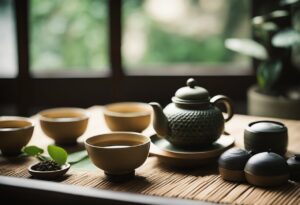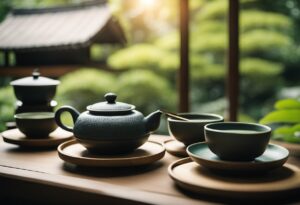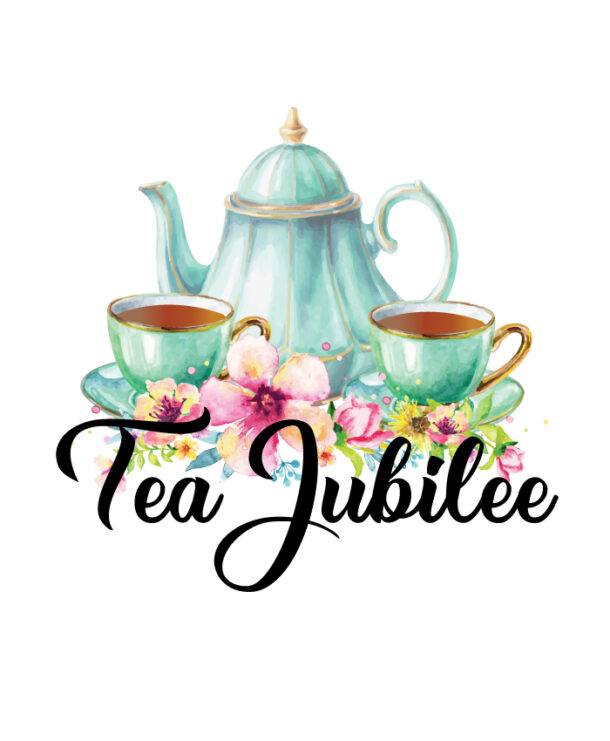==================
A Caveat and Affiliates
First off, a little caveat: within my articles you will find affiliate links, meaning if you buy them, I get a small commission. Your cost is not affected. In addition, I am an Amazon Associate and I earn from qualifying purchases on Amazon.
And yes, if I say that I recommend a product here, it means I truly believe it is a good product. I refuse to recommend any product that I have not researched and believe to be a good value.
Even better, I provide you with a very clear picture of the product, it’s use, and the probable value.
Earning your trust is important to me. I run this website myself and the commissions and donations help support the site.
Sound reasonable and fair enough? Let’s continue to the article.
==================
Contents
Yellow Matcha and its Benefits
Have you ever heard of Yellow Matcha? If not, then you’re in luck! I just wrote this blog post to find out what Yellow Matcha is and why you should try this out today!

What is yellow matcha?
Yellow matcha, also known as “Kuromame Matcha,” is a unique and rare powdered green tea that has recently gaining popularity. Unlike the vibrant green color of traditional matcha, yellow matcha has a distinctive pale yellow hue. This unique color results from a specialized cultivation and processing method that differentiates it from its more commonly known counterpart.
The production of yellow matcha begins with carefully selecting specific tea cultivars, such as the Kuromame cultivar, known for their natural tendency to produce a yellow-toned leaf. These tea plants are then meticulously shaded during the final stages of growth, which triggers the production of certain pigments and compounds within the leaves.
After harvesting, the leaves undergo a gentle steaming and drying process that preserves the tea’s delicate yellow color and unique flavor profile. The resulting powder, known as yellow matcha, has a smooth, mellow taste that is often described as less astringent and more umami-rich than traditional green matcha.
The origins of yellow matcha
The origins of yellow matcha can be traced back to the Uji region of Kyoto, Japan, which has long been recognized as a premier tea-producing area. In this picturesque region, dedicated tea farmers and artisans began experimenting with cultivating and processing this unique tea variety.
Through years of meticulous research and refinement, they were able to perfect the techniques required to produce the distinctive yellow matcha. This painstaking process, which involves carefully controlling the shading and drying of the tea leaves, has made yellow matcha a true rarity in tea.
Today, the production of yellow matcha remains centered mainly in the Uji region, with a small number of dedicated tea farms and artisanal producers continuing to uphold the traditional methods that give this tea its unique character.

The differences between yellow matcha and green matcha
While both yellow matcha and green matcha are derived from the Camellia sinensis plant, the two varieties differ in several key ways:
- Color: As mentioned, the most obvious difference is the color, with yellow matcha boasting a pale, golden-yellow hue compared to the vibrant green of traditional matcha.
- Flavor Profile: Yellow matcha is known for its smooth, mellow, and less astringent taste, often described as having a more umami-rich and balanced flavor profile compared to the more robust and grassy notes of green matcha.
- Cultivation Process: The unique yellow color of this tea is the result of a specialized cultivation process that involves shading the tea plants during the final stages of growth, which triggers the production of certain pigments and compounds within the leaves.
- Nutritional Composition: While both varieties of matcha contain a range of beneficial nutrients, the specific composition can vary due to the differences in cultivation and processing methods. Yellow matcha may exhibit slightly different concentrations of certain antioxidants, amino acids, and other phytonutrients than its green counterpart.
- Rarity and Availability: Due to the specialized and labor-intensive cultivation process, yellow matcha is generally considered a more exclusive tea variety, with limited production and availability compared to the more widely produced green matcha.
The health benefits of yellow matcha

Like its green counterpart, yellow matcha is rich in various beneficial compounds that can contribute to overall health and well-being. Some of the key health benefits associated with yellow matcha include:
- Antioxidant Properties: Yellow matcha contains potent antioxidants, including catechins and polyphenols, that can help neutralize harmful free radicals and support cellular health.
- Improved Cognitive Function: The amino acid L-theanine, present in yellow matcha, has been shown to promote relaxation and focus, potentially enhancing cognitive performance and mental clarity.
- Immune System Support: Yellow matcha contains a range of vitamins, minerals, and other nutrients that can help bolster the immune system and support the body’s natural defenses.
- Cardiovascular Health: The bioactive compounds in yellow matcha may help support healthy blood pressure levels, improve circulation, and reduce the risk of certain cardiovascular diseases.
- Digestive Benefits: The unique flavor profile and composition of yellow matcha may help soothe the digestive system and promote healthy gut function.
How to prepare yellow matcha
Preparing a delicious cup of yellow matcha requires a few simple steps:
- Gather the Necessary Supplies: You’ll need a traditional matcha bowl (chawan), a matcha whisk (chasen), and a high-quality yellow matcha powder.
- Sift the Powder: Use a fine-mesh sieve to gently sift the yellow matcha powder, ensuring a smooth and lump-free consistency.
- Add Hot Water: Pour hot water (around 175-195°F) into the matcha bowl, and then add a small amount of the sifted powder, typically around 1-2 teaspoons per serving.
- Whisk Vigorously: Using the matcha whisk, briskly whisk the powder and water together in a back-and-forth motion, creating a smooth, frothy texture.
- Enjoy: Savor this unique tea’s smooth, umami-rich flavor and vibrant color once the yellow matcha is thoroughly whisked.
For a more ceremonial experience, you can incorporate traditional Japanese matcha preparation techniques, such as the chanoyu (tea ceremony) ritual.
Incorporating yellow matcha into your daily routine
Enjoying yellow matcha can be a fantastic way to incorporate mindfulness and tranquility into your daily routine. Here are a few ideas for incorporating this unique tea into your lifestyle:
- Start Your Day with a Cup of Yellow Matcha: Begin your morning with an energizing and nourishing cup of yellow matcha, savoring its smooth, mellow flavor and potential benefits.
- Incorporate Yellow Matcha into Your Wellness Routine: Add a scoop of yellow matcha powder to your smoothies, yogurt, or oatmeal to boost your intake of antioxidants and other beneficial compounds.
- Explore Yellow Matcha-Infused Recipes: Experiment with incorporating yellow matcha into various dishes, from baked goods and desserts to savory meals and beverages.
- Enjoy a Midday Matcha Break: Take a moment to pause and indulge in a soothing cup of yellow matcha, allowing yourself a brief respite from the day’s demands.
- Share the Yellow Matcha Experience: Introduce friends and family to the unique qualities of yellow matcha, and host a tasting or tea ceremony to share the experience.
Yellow matcha recipes and ideas
Exploring the versatility of yellow matcha opens up a world of culinary possibilities. Here are a few delicious recipe ideas to get you started:
- Yellow Matcha Latte: Whisk together yellow matcha powder, hot milk (dairy or non-dairy), and a touch of sweetener for a creamy, comforting beverage.
- Yellow Matcha Smoothie: Blend yellow matcha powder with your choice of fruits, vegetables, yogurt, and other nourishing ingredients for a nutrient-dense and refreshing smoothie.
- Yellow Matcha Muffins or Scones: Incorporate yellow matcha powder into your baking, creating delightful pastries with a unique flavor profile.
- Yellow Matcha Ice Cream or Sorbet: Infuse your homemade ice cream or sorbet with the vibrant hues and delicate taste of yellow matcha.
- Yellow Matcha-Infused Salad Dressing: Whisk together yellow matcha powder, olive oil, vinegar, and other seasonings for a flavorful and nutritious salad dressing.
Where to buy yellow matcha
As a relatively rare and specialized tea variety, yellow matcha can be more challenging to find compared to its green counterpart. However, with the growing interest in this unique tea, more and more reputable tea vendors and online retailers are beginning to offer high-quality yellow matcha options.
When sourcing yellow matcha, it’s essential to look for products from trusted, artisanal producers in the Uji region of Japan, as this is where most of the world’s yellow matcha is cultivated and processed. Additionally, look for certifications and information about the specific cultivation and processing methods to ensure you get an authentic and high-quality product.
Some reliable sources for purchasing yellow matcha include specialty tea shops, online tea retailers, and direct-from-farm vendors. It’s always a good idea to research the brand and read customer reviews to ensure you’re getting a product that meets your expectations regarding quality and flavor.
Frequently asked questions about yellow matcha.
Q: What is the difference between yellow matcha and green matcha? A: The primary differences between yellow matcha and green matcha lie in their color, flavor profile, cultivation process, and nutritional composition. Yellow matcha has a pale, golden-yellow hue and a smooth, mellow taste, while green matcha is vibrant green and has a more robust, grassy flavor.
Q: Is yellow matcha healthier than green matcha? A: Yellow and green matcha contain beneficial compounds, including antioxidants, amino acids, and other nutrients. While the specific nutritional profiles may vary slightly due to the differences in cultivation and processing, both varieties offer impressive health benefits. The choice between the two often comes down to personal preference and taste.
Q: How do I store yellow matcha properly? A: To preserve the quality and freshness of yellow matcha, it’s essential to store it in an airtight container, away from direct sunlight, heat, and moisture. Keep the container in a cool, dry place, and consider refrigerating or freezing the powder for extended storage.
Q: Can I use yellow matcha in the same way as green matcha? A: Yes, you can generally use yellow matcha in the same way as green matcha. It can be whisked into hot water to create a traditional matcha tea, incorporated into baked goods and desserts, blended into smoothies, and used in various culinary applications.
Q: Where can I find yellow matcha? A: As a more specialized and rare tea variety, yellow matcha can be more challenging than green matcha. Your best options are to seek out reputable tea shops, online retailers, and direct-from-farm vendors specializing in high-quality Japanese teas, particularly those from the Uji region.
Conclusion: The future of yellow matcha
As the world of tea continues to evolve and expand, the unique and captivating qualities of yellow matcha are sure to captivate the hearts and palates of tea enthusiasts around the globe. With its mellow flavor profile, vibrant color, and impressive health benefits, this rare and specialized tea variety offers a genuinely exceptional sensory experience.
As you’ve discovered, yellow matcha is a remarkable and versatile tea that can be enjoyed in various ways. Suppose you’re ready to embark on a delightful journey of exploring the wonders of yellow matcha. Therefore, I encourage you to visit our online tea shop and browse our carefully curated selection. Discover the perfect yellow matcha to elevate your daily routine and unlock culinary possibilities. Shop now and savor the extraordinary taste of this unique tea.
More From Tea Jubilee.
21 Benefits of Green Tea Matcha
And that’s all for today. Thank you for reading this blog post about Yellow matcha and its benefits!
If you enjoyed this and my other content, feel free to share it with friends and family so they can also read about teas from Tea Jubilee.
Have a great day!




